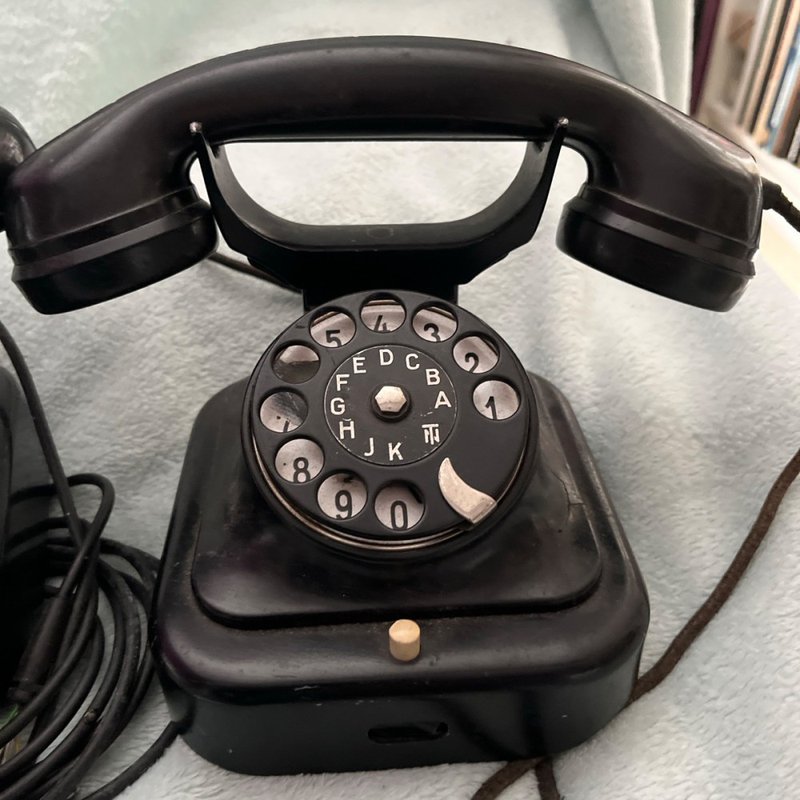Introduction: The Birth of Remote Art Creation
In 1922, László Moholy-Nagy, a visionary artist of the Bauhaus movement, created a revolutionary breakthrough in the intersection of art and technology. His "Telephone Pictures" fundamentally challenged traditional concepts of artistic production and laid the groundwork for a new era in art creation. By using the telephone to transmit his designs to an enamel factory, Moholy-Nagy not only questioned the artist's role but anticipated digital art production nearly a century before its time.
This pioneering approach—creating art remotely through technological mediation—foreshadowed our contemporary digital world where designs are routinely transmitted electronically for production. What makes this achievement particularly remarkable is that Moholy-Nagy conceived this method decades before such practices became commonplace, demonstrating the Bauhaus movement's forward-thinking approach to integrating art, design, and emerging technologies.

The Revolutionary Concept: Art by Telephone
László Moholy-Nagy, a prominent representative of the Bauhaus movement, revolutionized artistic production with his Telephone Pictures (1922). By conceiving these works over the telephone, without direct physical contact with the materials, he employed the technological means of his time to challenge traditional notions of artistic creation. These works not only emphasized the role of the artist as a conceptual creator but also highlighted the significance of technology in the creative process.
The Telephone Pictures, designated as Em 1, Em 2, and Em 3, are characterized by abstract, geometric compositions. The production was accomplished by transmitting instructions to an enamel factory, blurring the boundaries between art and industrial production. The pictures Em 1, Em 2, and Em 3 represent the same motif executed in different sizes. The naming of the pictures is based on an abbreviation of the title "Construction in Enamel 1," "2," and "3," respectively.
Moholy-Nagy described his process with remarkable clarity:
"I had the factory's colour chart before me and I sketched my paintings on graph paper. At the other end of the telephone the factory supervisor had the same kind of paper, divided into squares. He took down the dictated shapes in the correct position. (It was like playing chess by correspondence.) One of the pictures was delivered in three different sizes, so that I could study the subtle differences in the colour relations caused by the enlargement and reduction."
This methodical approach reveals how carefully Moholy-Nagy considered the technical challenges of his experiment. By ordering the same design in three different sizes, he implemented a manual error correction process, demonstrating his awareness of the relationship between image size and color perception. The media transition—from paper, color charts, and colored pencils on one side to processed enamel colors on metal on the other—could not be solved purely theoretically but required a practical approach.
Historical Context: Technological Precursors and Influence
The creation of these artworks occurred at a time when technical capabilities for image transmission were already advancing. The development of the "copying telegraph" by Alexander Bain in 1843 and later by Frederick Collier Bakewell in 1848 represented the first steps toward modern fax technology. In 1906, Arthur Korn succeeded in sending the first telegraphically transmitted portrait over a distance of 1,800 kilometers, further advancing the possibilities of image transmission.
These historical achievements demonstrate that Moholy-Nagy, with his Telephone Pictures, was not only challenging the art world but also visionary in grasping the potential of technology for creative processes. The method of image transmission later gained renewed attention, for example in the exhibition "Art by Telephone" at the Museum of Contemporary Art in Chicago in 1969. However, the transmission by the 36 artists there was far less formalized (using graph paper and color cards), focusing more on general descriptions/instructions for artworks to be created by museum staff. Moholy-Nagy's method was much more technical and objective, as evident from his own description of the process.

Anticipating the Digital Age: A Technological Leap Forward
The automated technical transmission of color images was not invented until 1940 by Mexican inventor Guillermo González Camarena. László Moholy-Nagy's artistic method thus anticipated technological development by nearly two decades. An image with a resolution of 100 x 100 pixels and 256 colors would be transmitted as a numerical sequence of 30,000 characters. As demonstrated by the example image, all relevant information is preserved even at this low resolution.
Of course, the capture (collecting color values for each pixel) and reproduction (applying the respective colors to a predetermined grid) would require considerable time with the artist's manual approach. Nevertheless, the possibilities of the process are fascinating.
Moholy-Nagy's experiment is particularly significant because it conceptually parallels modern digital image transmission. Today, we routinely send digital files containing precise pixel and color information for reproduction on various devices and in various media—exactly what Moholy-Nagy was doing manually, without computers, through verbal description.
The Bauhaus Connection: Art Meets Technology
Moholy-Nagy's Telephone Pictures epitomize the Bauhaus philosophy of combining art, craft, and technology. Founded in 1919 by Walter Gropius, the Bauhaus school sought to reimagine the material world and train a new generation of artists to embrace the potential of industrialization rather than resist it.
As a teacher at the Bauhaus from 1923 to 1928, Moholy-Nagy championed the integration of new technologies into artistic practice. His work with photography, film, and the Telephone Pictures demonstrated his belief that artists should embrace modern production methods rather than remain confined to traditional craftsmanship.
The Telephone Pictures represent a radical departure from the conventional understanding of artistic creation at the time. By separating the conception of the artwork from its physical execution, Moholy-Nagy challenged the romantic notion of the artist's hand as essential to artistic expression. Instead, he proposed a model where the artist functions more as a designer or director, conceiving the work while delegating its execution to others with specialized technical expertise.
This approach anticipated many aspects of contemporary art practice, where artists frequently work with fabricators, digital tools, and industrial processes to realize their visions. The Telephone Pictures foreshadowed the conceptual art movement of the 1960s, which would further explore the primacy of the idea over the physical artifact.
Technical Details and Production Context
The pictures were produced by the company Weimarische Emaille-Schilderfabrik Stark & Riese (Tannroda), which went bankrupt in 1934. After 1935, it operated as Thüringer Email – Schilderfabrik GmbH, and from 1946 as a state-owned enterprise (VEB), ultimately ceasing operations in 1968.
In many sources, the year of creation for the works Em 1, Em 2, and Em 3 is given as 1923. László Moholy-Nagy himself states the creation year as 1922. Here, one must clearly distinguish between the actual process of transmission, the production of samples, and the final execution. The final pictures were technically produced in 1923, according to Moholy-Nagy's book "The New Vision and Abstract of an Artist" (New York, 1947, p. 79).


Conclusion: Legacy and Influence
László Moholy-Nagy's Telephone Pictures stand not only as evidence of the innovative thinking within the Bauhaus movement but also as a testament to the inseparable connection between art and technology. These works illustrate how the Bauhaus functioned as a catalyst for the fusion of these two domains, laying the foundation for the modern understanding of art that views technology as an essential tool and source of inspiration.
By creating art "remotely" through technical mediation, Moholy-Nagy anticipated practices that would become commonplace in the digital age. His methodology questioned fundamental aspects of artistic creation, including authorship, materiality, and the relationship between concept and execution. In doing so, he opened new avenues for artistic expression that continue to be explored today.
The Telephone Pictures mark a turning point in art by emphasizing technology as an essential component of the creative process. These works, conceived over the telephone, not only highlight the role of the artist as a conceptual creator but also question the boundaries between art and industrial production. The method of transmitting art by telephone, later taken up in exhibitions such as "Art by Telephone," demonstrates the advanced technical possibilities for image transmission of his time. Moholy-Nagy's experimental approach underscores the importance of the Bauhaus for the integration of art and technology, a legacy that continues to this day.
As we navigate an increasingly digital world where remote collaboration and digital fabrication have become standard practice, Moholy-Nagy's visionary experiment reminds us that the conceptual foundations of these developments were laid nearly a century ago. His work stands as a powerful example of how artistic innovation can anticipate technological progress, revealing the profound interconnections between creative thinking and technological advancement.
References:
- László Moholy-Nagy, "The New Vision and Abstract of an Artist", New York, 1947.
- fotoMAGAZIN – History of Image Transmission. Link
- Der Spiegel – Calendar Sheet 10/17/1906. Link
- Press kit for the exhibition "Die Schulung der Sinne durch Kunst" 2014/2015. Link
Image Links (not embedded for copyright reasons):
- Em1: https://www.moholy-nagy.org/art-database-detail/55?prev=gallery
- Em 2: https://www.moholy-nagy.org/art-database-detail/54?prev=gallery
- Em 3: https://www.moholy-nagy.org/art-database-detail/53?prev=gallery
#LászlóMoholyNagy #BauhausMovement #Bauhaus #ArtAndTechnology #TelephonePictures #InnovationInArt #Innovation #Art #CreativeProcesses #ModernArtHistory #ArtHistory #DesignThinking #FutureOfArt #Future #RemoteCreation #DigitalArt
